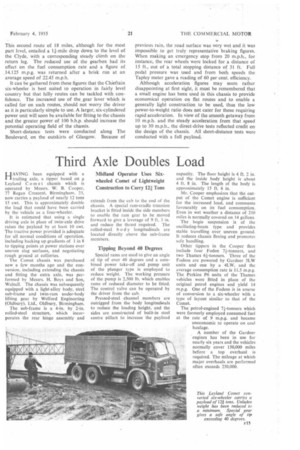Third Axle Doubles Load
Page 61

If you've noticed an error in this article please click here to report it so we can fix it.
Midland Operator Uses Sixwheeled Comet of Lightweight Construction to Carry 1.2i Tons r_TAVTNG been equipped with a I. /trailing axle, a tipper based on p, Leyland Comet chassis which is operated by Messrs. W. B. Cooper, 77 Regan Crescent, Birmingham, 23, now carries a payload of nearly 12 tons 15 cwt. This is approximately double the load that could have been carried by the vehicle as a four-wheeler.
It is estimated that using a single driving axle in place of twin-axle drive raises the payload by at least 10 cwt. The tractive power provided is adequate for all normal conditions of operation, including backing up gradients of 1 in 8 to tipping points at power stations over uneven slag surfaces, and negotiating rough ground at collieries.
The Comet chassis was purchased new a few months ago and the conversion, including extending the chassis and fitting the extra axle, was performed by Messrs. H. Boys and Son, Walsall. The chassis was subsequently equipped with a light-alloy body, steel sub-frame and twin-ram under-body lifting gear by Welford Engineering (Oldbury), Ltd., Oldbury, Birmingham.
The sub-frame is a 4-in. by 2-in. rolled-steel structure, which incorporates the rear hinge assembly and extends from the cab to the end of the chassis. A special ram-cradle trunnion bracket is fitted inside the side members to enable the ram gear to be moved forward to give a leverage of 9 ft. 3 in. and reduce the thrust required. The rolled-steel body longitudinals are located directly above the sub-frame members.
Tipping Beyond 40 Degrees
Special rams are used to give an angle of tip of over 40 degrees and a combined power take-off and pump unit of the plunger type is employed to reduce weight. The working pressure of the pump is 2,500 lb, which enables rams of reduced diameter to be fitted. The control yalve can be operated by the driver from the cab.
Pressed-steel channel members are outrigged from the body longitudinals to reduce the loading height, and the sides are constructed of built-in steel centre pillars to increase the payload capacity. The floor height is 4 ft. 2 in. and the inside body height is about 4 ft, 8 in. The length of the body is approximately 15 ft. 6 in.
Mr. Cooper emphasizes that the output of the Comet engine is sufficient for the increased load, and comments favourably on its fuel consumption. Even in wet weather a distance of 210 miles is normally covered on 14 gallons.
The bogie suspension is of the oscillating-beam type and provides stable travelling over uneven ground. It reduces chassis flexing and promotes safe handling.
Other tippers in the Cooper fleet include four Foden 71-tonners, and two Thames 61-tonners, Three of the Fodens are powered by Gardner 5LW units and one by a 4LW, and the average consumption rate is 11.5 m.p.g. The Perkins P6 units of the Thames vehicles were fitted in place of the original petrol engines and yield 14 m.p.g. One of the Fodens is in course of conversion to a six-wheeler with a type of layout similar to that of the Comet.
The petrol-engined 7i-tonners which were formerly employed consumed fuel at the rate of 9 m.p.g. and became uneconomic to operate on coal haulage.
A number of the Gardner engines has been in use for nearly six years and the vehicles normally cover 150,000 miles before a top overhaul is required. The mileage at which major overhauls are performed often exceeds 250,000.




















































































































